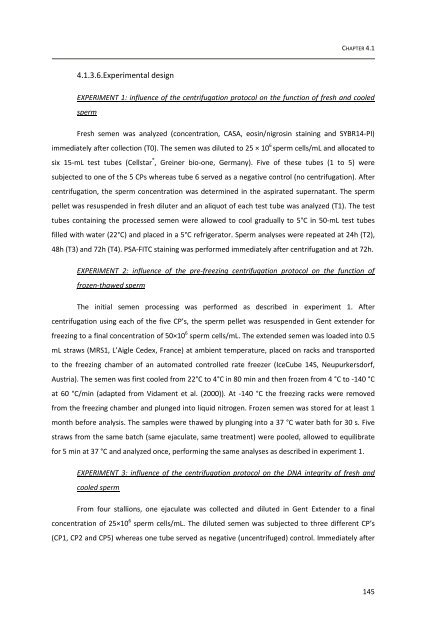view - Department of Reproduction, Obstetrics and Herd Health
view - Department of Reproduction, Obstetrics and Herd Health
view - Department of Reproduction, Obstetrics and Herd Health
Create successful ePaper yourself
Turn your PDF publications into a flip-book with our unique Google optimized e-Paper software.
4.1.3.6.Experimental design<br />
CHAPTER 4.1<br />
EXPERIMENT 1: influence <strong>of</strong> the centrifugation protocol on the function <strong>of</strong> fresh <strong>and</strong> cooled<br />
sperm<br />
Fresh semen was analyzed (concentration, CASA, eosin/nigrosin staining <strong>and</strong> SYBR14-PI)<br />
immediately after collection (T0). The semen was diluted to 25 × 10 6 sperm cells/mL <strong>and</strong> allocated to<br />
six 15-mL test tubes (Cellstar ® , Greiner bio-one, Germany). Five <strong>of</strong> these tubes (1 to 5) were<br />
subjected to one <strong>of</strong> the 5 CPs whereas tube 6 served as a negative control (no centrifugation). After<br />
centrifugation, the sperm concentration was determined in the aspirated supernatant. The sperm<br />
pellet was resuspended in fresh diluter <strong>and</strong> an aliquot <strong>of</strong> each test tube was analyzed (T1). The test<br />
tubes containing the processed semen were allowed to cool gradually to 5°C in 50-mL test tubes<br />
filled with water (22°C) <strong>and</strong> placed in a 5°C refrigerator. Sperm analyses were repeated at 24h (T2),<br />
48h (T3) <strong>and</strong> 72h (T4). PSA-FITC staining was performed immediately after centrifugation <strong>and</strong> at 72h.<br />
EXPERIMENT 2: influence <strong>of</strong> the pre-freezing centrifugation protocol on the function <strong>of</strong><br />
frozen-thawed sperm<br />
The initial semen processing was performed as described in experiment 1. After<br />
centrifugation using each <strong>of</strong> the five CP’s, the sperm pellet was resuspended in Gent extender for<br />
freezing to a final concentration <strong>of</strong> 50×10 6 sperm cells/mL. The extended semen was loaded into 0.5<br />
mL straws (MRS1, L’Aigle Cedex, France) at ambient temperature, placed on racks <strong>and</strong> transported<br />
to the freezing chamber <strong>of</strong> an automated controlled rate freezer (IceCube 14S, Neupurkersdorf,<br />
Austria). The semen was first cooled from 22°C to 4°C in 80 min <strong>and</strong> then frozen from 4 °C to -140 °C<br />
at 60 °C/min (adapted from Vidament et al. (2000)). At -140 °C the freezing racks were removed<br />
from the freezing chamber <strong>and</strong> plunged into liquid nitrogen. Frozen semen was stored for at least 1<br />
month before analysis. The samples were thawed by plunging into a 37 °C water bath for 30 s. Five<br />
straws from the same batch (same ejaculate, same treatment) were pooled, allowed to equilibrate<br />
for 5 min at 37 °C <strong>and</strong> analyzed once, performing the same analyses as described in experiment 1.<br />
EXPERIMENT 3: influence <strong>of</strong> the centrifugation protocol on the DNA integrity <strong>of</strong> fresh <strong>and</strong><br />
cooled sperm<br />
From four stallions, one ejaculate was collected <strong>and</strong> diluted in Gent Extender to a final<br />
concentration <strong>of</strong> 25×10 6 sperm cells/mL. The diluted semen was subjected to three different CP’s<br />
(CP1, CP2 <strong>and</strong> CP5) whereas one tube served as negative (uncentrifuged) control. Immediately after<br />
145









